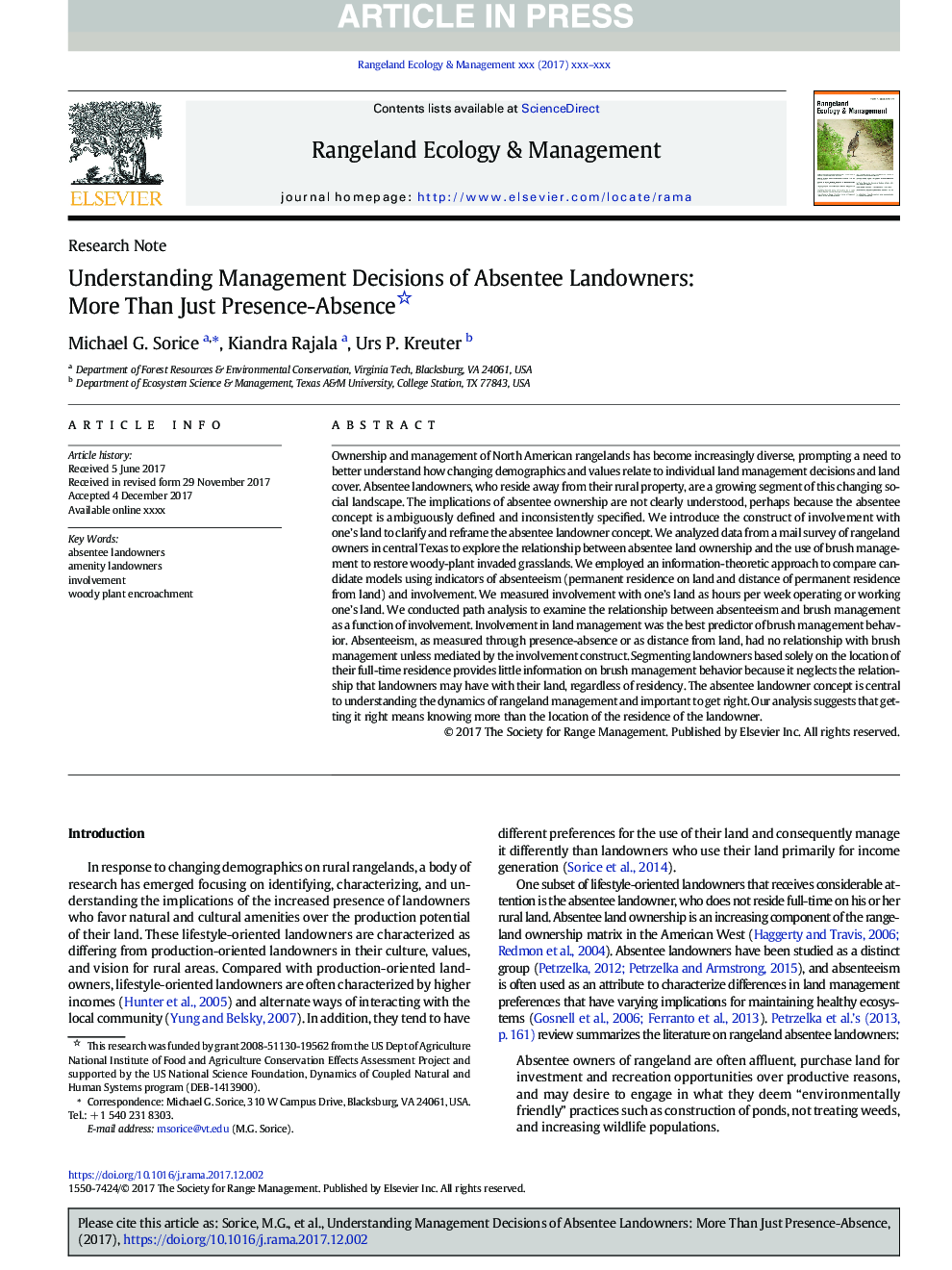| کد مقاله | کد نشریه | سال انتشار | مقاله انگلیسی | نسخه تمام متن |
|---|---|---|---|---|
| 8849618 | 1618645 | 2018 | 4 صفحه PDF | دانلود رایگان |
عنوان انگلیسی مقاله ISI
Understanding Management Decisions of Absentee Landowners: More Than Just Presence-Absence
ترجمه فارسی عنوان
درک تصمیم های مدیریت از صاحبان زمین لایحه: بیشتر از حضور در دسترس نیست
دانلود مقاله + سفارش ترجمه
دانلود مقاله ISI انگلیسی
رایگان برای ایرانیان
کلمات کلیدی
مالکان غیابی صاحبان اموال، درگیری، نفوذ گیاه چوبی،
ترجمه چکیده
مالکیت و مدیریت مراتع آمریکای شمالی به طور فزاینده ای متنوع شده است، و باعث می شود نیاز بیشتری به درک چگونگی تغییر جمعیت و ارزش ها در ارتباط با تصمیمات مدیریت زمین فردی و پوشش زمین. صاحبان مزبور که از مالکیت روستایی خود ساکن هستند، بخش رو به رشدی از این چشم انداز اجتماعی تغییر می کنند. مفاهیم مالکیت غیبت به وضوح درک نمی شود، شاید به این دلیل که مفهوم غیبت مبهم مبهم و تعریف نشده است. ما ساختار مشارکت با زمین را معرفی می کنیم تا مفهوم اموال غایب را اصلاح و اصلاح کنیم. ما داده ها را از طریق بررسی نامه صاحبان مراتع در مرکز تگزاس تحلیل کردیم تا رابطه بین مالکیت زمین غایب و استفاده از مدیریت برس برای بازگرداندن گیاهان تحت تاثیر قرار گیرد. ما روش رویکردی اطلاعاتی را برای مقایسه مدلهای نامزد با استفاده از شاخصهای غیبت (محل سکونت دائم در زمین و فاصله اقامت دائم از زمین) و دخالت به کار گرفتیم. ما درگیر شدن با سرزمین خودمان به عنوان ساعت در هفته فعالیت یا کار زمین را سنجیدیم. ما تجزیه و تحلیل مسیر را برای بررسی رابطه بین غیبت و مدیریت برس به عنوان تابع مشارکت انجام دادیم. مشارکت در مدیریت زمین بهترین پیش بینی کننده رفتار رفتار برس بود. عدم غیبت، با توجه به نبود حضور و یا فاصله از زمین، بدون ارتباط با مدیریت قلم مواج نیست، مگر اینکه توسط سازنده درگیر دخالت کند. تقسیم مالکین زمین که صرفا بر اساس محل سکونت آنها تمام وقت است، اطلاعات کمی در مورد رفتار مدیریت برس ارائه می دهد، زیرا بدون در نظر گرفتن محل اقامت، رابطه ای که مالکان ممکن است با زمین خود داشته باشند، نادیده گرفته می شود. مفهوم اموال غایب برای درک پویایی مدیریت مرتع مهم است و برای رسیدن به اهمیت مهم است. تجزیه و تحلیل ما نشان می دهد که بدست آوردن این حق به معنای دانستن بیشتر از محل اقامت مالک زمین است.
موضوعات مرتبط
علوم زیستی و بیوفناوری
علوم کشاورزی و بیولوژیک
علوم کشاورزی و بیولوژیک (عمومی)
چکیده انگلیسی
Ownership and management of North American rangelands has become increasingly diverse, prompting a need to better understand how changing demographics and values relate to individual land management decisions and land cover. Absentee landowners, who reside away from their rural property, are a growing segment of this changing social landscape. The implications of absentee ownership are not clearly understood, perhaps because the absentee concept is ambiguously defined and inconsistently specified. We introduce the construct of involvement with one's land to clarify and reframe the absentee landowner concept. We analyzed data from a mail survey of rangeland owners in central Texas to explore the relationship between absentee land ownership and the use of brush management to restore woody-plant invaded grasslands. We employed an information-theoretic approach to compare candidate models using indicators of absenteeism (permanent residence on land and distance of permanent residence from land) and involvement. We measured involvement with one's land as hours per week operating or working one's land. We conducted path analysis to examine the relationship between absenteeism and brush management as a function of involvement. Involvement in land management was the best predictor of brush management behavior. Absenteeism, as measured through presence-absence or as distance from land, had no relationship with brush management unless mediated by the involvement construct. Segmenting landowners based solely on the location of their full-time residence provides little information on brush management behavior because it neglects the relationship that landowners may have with their land, regardless of residency. The absentee landowner concept is central to understanding the dynamics of rangeland management and important to get right. Our analysis suggests that getting it right means knowing more than the location of the residence of the landowner.
ناشر
Database: Elsevier - ScienceDirect (ساینس دایرکت)
Journal: Rangeland Ecology & Management - Volume 71, Issue 2, March 2018, Pages 159-162
Journal: Rangeland Ecology & Management - Volume 71, Issue 2, March 2018, Pages 159-162
نویسندگان
Michael G. Sorice, Kiandra Rajala, Urs P. Kreuter,
